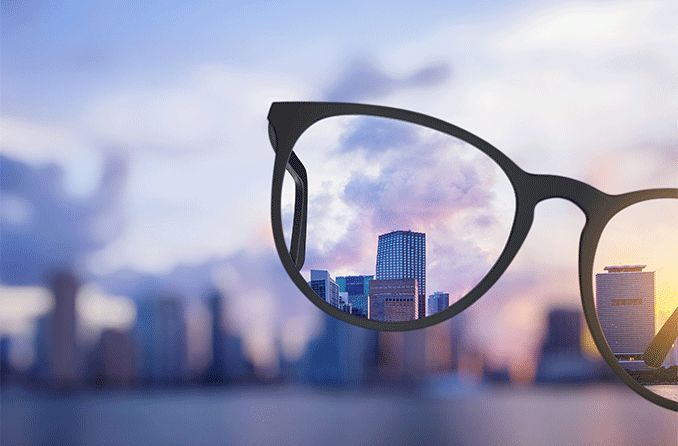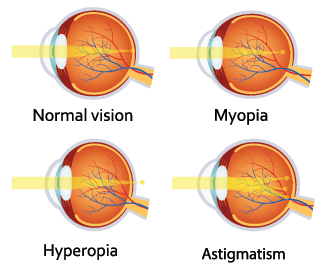Ametropia: Description, prevalence and treatment

What is ametropia?
Ametropia is the medical term for the presence of refractive error in the eyes. It occurs when the eye is not able to focus light rays from an object directly onto the retina to provide a clear image. Ametropia includes refractive error due to myopia, hyperopia and astigmatism.
Refractive errors occur when the eye cannot focus light rays from a distance object directly onto the retina. In myopia (nearsightedness), the light rays come to a focus in front of the retina. In hyperopia (farsightedness), light rays come to a focus behind the retina. In astigmatism, light rays focus at several different points, instead of at a single point.
How does ametropia affect people’s lives around the world?
Ametropia is the most common eye problem in people of all ages around the world. A recent review of vision impairment and blindness around the world found that uncorrected refractive error was responsible for visual impairment in more than 100 million people worldwide. Blindness was found in nearly 7 million people. This is the equivalent of nearly one in 100 people in the world with decreased or lost vision due to ametropia.
Uncorrected ametropia has countless negative outcomes for individuals, their families and society in general. Poverty and poor access to eye care prevent many people around the world from receiving treatment to correct their refractive error. This has a ripple effect of decreased socioeconomic status for these individuals and their families. Education and employment opportunities become limited for those who suffer from ametropia.
Thanks to increasing awareness and medical outreach, the prevalence of visual impairment and blindness due to ametropia decreased by nearly one third from 1990 to 2010.
RELATED READING: Visual impairment around the world
What causes myopia, hyperopia and astigmatism?
Myopia
In myopia, light rays entering the eyes are focused at a point in front of the retina. This results in blurry distance vision. “Refractive myopia” can be due to a cornea or lens that is too steeply curved. It can also be due to the lens being too close to the cornea. More commonly, myopia is the result of the eyeball being too long relative to the focusing power of the eye. This is known as “axial myopia.” Axial myopia is the most common type of childhood myopia.

Myopia is considered to be the prevalent cause of refractive error in many countries. Researchers have found that myopia prevalence increases with several factors:
Less time spent outdoors
More time spent in near work activities at close viewing distance
Higher education
An alarming worldwide trend is the increased prevalence of myopia. Particularly in some East Asian countries, researchers have found that nearly four in five adults over age 18 are myopic. While not as high, the trend for increasing myopia has also occurred in the Western hemisphere. According to the American Optometric Association, myopia affects nearly one in three Americans.
Many strategies have been suggested to delay the onset, or slow the progression of, myopia, including:
Increased outdoor time
Topical low dose atropine
Novel myopia control glasses
Bifocal and progressive addition lenses
Multifocal and dual focus contact lenses
These strategies are critical because high myopia can increase the risk of vision-threatening conditions. These include retinal detachment, retinal tears, early onset of certain cataracts, glaucoma and myopia maculopathy. As such, the increase in myopia prevalence throughout the world has led to lost opportunity and productivity for millions globally.
Hyperopia
In hyperopia, light rays entering the eyes from a distance are focused at a point behind the retina. This results in a blurry image. The most common cause of hyperopia is that the eyeball is too short relative to the focusing power of the cornea and lens.
The prevalence of hyperopia in the U.S. is about one in 10 Americans. In babies, hyperopia is the most common refractive error. This hyperopia typically decreases within a few years as the baby grows into toddlerhood.
The current trends of refractive error around the world indicate that the prevalence of hyperopia is low compared to myopia.
Astigmatism
Astigmatism is the result of the refractive error of the eye being different in the meridians of the eye. Usually, it is due to the curve of the cornea or lens being somewhat irregular. The correction that is required to correct astigmatism is more complex than a simple spherical correction of myopia or hyperopia.
Factors that increase the risk of astigmatism include:
Farsightedness or nearsightedness
Black or Hispanic ethnicity
SEE RELATED: Can astigmatism cause myopia?
What is the risk of not detecting ametropia in babies and children?
Children may not realize that their blurry vision is not normal since they do not have another reference point. As a result, ametropia may go undetected. Uncorrected refractive error can put young children at risk for a condition called amblyopia (“lazy eye”). This condition can be treated if detected early. But, if detected too late, it can result in life-long decreased visual acuity and depth perception.
It is important to look for signs such as avoidance of near work activities, squinting, short attention span and eye strain in children. Children may perform poorly at school or in sports due to symptoms resulting from ametropia. Vision screenings are helpful in catching refractive errors. But a thorough exam with an eye doctor is necessary to detect and treat ametropia.
What are the symptoms of ametropia?
Ametropia can make daily tasks difficult. Reading, playing sports, cooking safely and driving safely all require clear vision. Symptoms of uncorrected ametropia include:
Eye strain and eye fatigue
Squinting to clear up the image
How is ametropia corrected?
Detection of refractive error usually occurs when an individual notices blurry vision. In children, it can be found by school screenings, parent observation, a child’s complaints or yearly visits to the eye doctor.
Ametropia can be corrected with:
Can ametropia be prevented?
Studies have shown that outdoor exposure can delay the onset of myopia. Eye doctors have begun to recommend that children spend 80-120 minutes (about 2 hours) outside each day. This can decrease the risk of myopia development.
Additionally, several strategies have been found to slow myopia progression, including:
Low-dose atropine drops instilled in the eyes at bedtime
Multifocal and competing defocus glasses and contact lenses
Overnight orthokeratology
Additionally, lifestyle changes can reduce eye strain and promote good visual habits. These include:
Taking breaks when doing near work to decrease eye strain. (Try the 20-20-20 rule: every 20 minutes, for 20 seconds, look at something at least 20 feet away.)
Don’t hold reading material too close. (Try the elbow rule: Keep reading material at least as far away as the distance from your face to your elbow.)
Decrease or limit screen time.
Use proper illumination. Keep the light pointing at your desk, not your eyes.
The first step to managing a refractive error is a comprehensive eye exam with a qualified eye doctor. Research on how to prevent or decrease the progression of ametropia, particularly myopia, is ongoing. Your eye doctor can recommend the most appropriate course of action after a full evaluation.
Global vision impairment and blindness due to uncorrected refractive error, 1990–2010. Optometry and Vision Science. March 2016.
Prevalence of refractive error in Europe: the European eye epidemiology consortium. European Journal of Epidemiology. March 2015.
Global variations and time trends in the prevalence of childhood myopia, a systematic review and quantitative meta-analysis: implications for aetiology and early prevention. British Journal of Ophthalmology. January 2016.
Myopia (nearsightedness). American Optometric Association. Accessed October 2021.
Practical applications to modify and control the development of ametropia. Eye. December 2013.
Hyperopia. American Academy of Ophthalmology. EyeWiki. February 2020.
Astigmatism. Cleveland Clinic Foundation. December 2020.
Myopia (nearsightedness). Cleveland Clinic Foundation. July 2020.
Page published on Tuesday, October 12, 2021
Medically reviewed on Sunday, February 13, 2022






